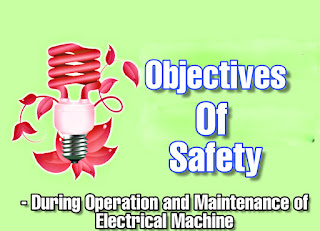Objectives of Safety During Operation and Maintenance of Electrical Machine.
Testing and maintenance of electrical machines is an important and critical job intended for safety of operating personnel surroundings, machines etc.
Procedures for testing and maintenance of electrical equipment are well defined and abide by the I.E. rules. These rules are to be strictly followed.
 |
| Objectives of safety during operation and maintenance of Electrical Machine |
Safety must be given top priority in the working process right from foundation,
commissioning, testing, working and maintenance of the equipment.
Objectives of Safety
From this brief discussion we can write the objectives as follows:
- To take care of equipment and persons concerned.
- To take care of the premises in which equipment is located.
- To take precautionary majors in transportation of equipment.
- To take precautions in loading and unloading of equipments.
- To take primary inspections, that wirings, fittings and accessories are not damaged.
- To take precautions for proper assembling of parts.
- There are I.E. acts/rules for safety at work.
- Printed cards are to be made available, and displaced at proper places.
- Warning signs are to be displayed.
- Permit to work 'permit cards' are be issued.
- To give work-book keeping awareness.
- To give responsibility of work to responsible person, supervisors.
- To take immediate actions in emergency cases.
- To give training - 'How to avoid accidents'.
- Put Do's and Don'ts lists.
- To give training for causes of electric shock, how to avoid and take care.
- To give training to cure persons from electric shock.
- To train a group of persons for artificial respiration method.
- To make aware from causes of electric fire how to attack fire.
- To keep equipment periodically tested "as fire extinguishers"
- Issue draft of permit to work and to shut down
- To keep a card explaining "Know your machine".
- To keep time table well displaced giving program of maintenance schedule, hourly,
- daily, monthly, quarterly, half yearly, yearly.
- To check earthing system properly maintained.
You may Also Read:
- To check oil levels kept for safety and cooling of machine.
- Don't keep machine idle for a long period.
- If kept and to be now commissioned check its mechanical and electrical conditions and
- make necessary repairs, test, lubrications and then keep it ready for re-commissioning.
- Keep the earthing system in well condition.
- Check earth resistance.
- Check protective systems whether in proper condition to act in abnormal happenings.
- Warning bells, sirons to be kept ready in good conditions.
- Appoint trained and qualified persons for the jobs.
- Extend periodic training for new technology to be adopted.
- To keep linkages, contacts, by various methods available.
- Security department be aware and active and prompt in actions.
- Cleaners and creeping.
- Between two machine, appropriate clearance be kept for moments.
- Between conductors as per the voltage rating specified.
- Creepages, ground clearance of conductors as per line voltages be assured.
- If adjustments and repairs are to be taken, then follow proper procedures laid down by the department heads.
- Patrolling work be carried out at least once in a week to check the lines.
- For maintenance, a shutdown is taken. Give prior notice for the same to the consumers.

Very educating and important in everyday electrical job engagement, this is a good write up my friend.
ReplyDelete